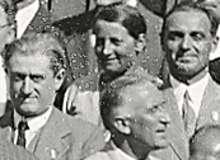Helene Stähelin
Helene Stähelin (18 July 1891 Wintersingen – 30 December 1970 Basel) was a Swiss mathematician, teacher, and peace activist.[1] Between 1948 and 1967, she was president of the Swiss section of the Women's International League for Peace and Freedom and its representative in the Swiss Peace Council.[2][3]

Early life and scientific work
She was one of twelve childs of the parson Gustav Stähelin (1858–1934)[4] and his wife Luise, née Lieb. In 1894, the family moved from Wintersingen to Allschwil. Helene Stähelin attended the Töchterschule Basel and the Universities Basel and Göttingen. In 1922, she became teacher of mathematics and natural sciences at the Töchterinstitut(de) in Ftan.[1] In 1924, she obtained her Dr.phil. degree[5] from Basel University for her dissertation Die charakteristischen Zahlen analytischer Kurven auf dem Kegel zweiter Ordnung und ihrer Studyschen Bildkurven, advised by Hans Mohrmann and Otto Spiess.[1][6][7] In 1926, she became a member of the Swiss Mathematical Society. Between 1934 and 1956, Helene Stähelin worked as teacher at the Protestant secondary school in Zug. After her pensioning she returned to Basel, where she assisted for several years to Otto Spiess' editing the Bernoulli family letters.[1][8]
Political activism
Being a pacifist, Helene Stähelin committed herself to the Women's International League for Peace and Freedom (Internationale Frauenliga für Frieden und Freiheit, IFFF) and its struggle against scientific warfare. She was president of the IFFF's Swiss section in 1947–1967, when the main issues were the United Nations Organization, nuclear weapons, and the Vietnam War.[1] Due to her peace activism, she was watched by Swiss authorities in the mid 1950s,[1] her file at the Swiss Public Prosecutor General was kept secret until 1986.[5] Helene Stähelin also was active towards Women's suffrage in Switzerland,[1] which was, however, not gained during her lifetime.
References
- Manuela Nipp. "Personenlexikon des Kanton Basel-Landschaft — Helene Stähelin". Retrieved 25 Jun 2017.
- Regula Ludi. "No 12 — Stähelin, Helene". Retrieved 25 Jun 2017.
- Irene Willi. "Geschichte der WILPFSchweiz — Eine Bewegung entsteht". Retrieved 25 Jun 2017.
- ""Online Catalogue of the State Archives Basel-Stadt — PA 182a B 55 Gustav Stähelin-Lieb (1858-1934), Pfr. § 113 bzw. 207 neu, s.d. (sine dato) (Serie)". Retrieved 25 Jun 2017.
- "Online Catalogue of the State Archives Basel-Stadt — PA 182a B 90 Helene Staehelin (1891-1971), Dr. phil. § 207,4 neu, 1955 (Serie)". Retrieved 25 Jun 2017.
- Helene Stähelin (1924). Die charakteristischen Zahlen analytischer Kurven auf dem Kegel zweiter Ordnung und ihrer Studyschen Bildkurven (Ph.D. thesis). Basel University.
- Helene Stähelin (1925). "Die charakteristischen Zahlen analytischer Kurven auf dem Kegel zweiter Ordnung und ihrer Studyschen Bildkurven" (PDF). Mathematische Annalen. 93: 217–229. doi:10.1007/BF01449961.
- S. Gehr, F. Nagel, B. v. Reibnitz (Ed.), Editionen in Basel, 2010, p.22-23 (20-21)